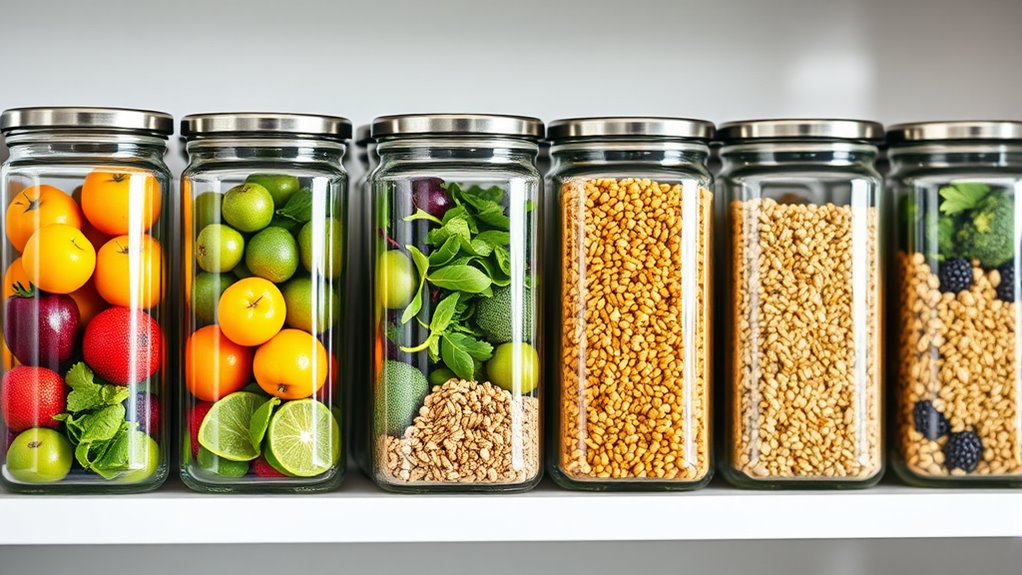Using airtight containers helps you prevent food waste by creating a sealed environment that keeps out air, moisture, and bacteria. This slows spoilage, preserves flavor and texture, and extends the freshness of fruits, vegetables, and leftovers. Properly selecting the right size and maintaining the seals guarantees your food stays fresh longer. Organized, labeled containers also make meal prep easier. Keep exploring to discover how to maximize your food storage and reduce waste even more effectively.
Key Takeaways
- Airtight containers create sealed environments that prevent air contact, slowing spoilage and extending food freshness.
- Properly sealed containers preserve moisture, flavors, and textures, reducing waste from spoiled or dried-out food.
- Selecting the right size and shape maximizes storage efficiency and minimizes space, reducing clutter and potential spills.
- Regular maintenance, including checking seals and cleaning, ensures containers remain effective at preventing spoilage.
- Clear, labeled containers facilitate quick identification and rotation of food, helping to prevent forgotten or expired items.

Have you ever wondered how to keep your food fresh and safe for longer periods? One of the most effective ways is by using airtight containers. These containers create a sealed environment that prevents air from reaching your food, which slows down spoilage and keeps your ingredients tasting their best. When you store leftovers, snacks, or ingredients in airtight containers, you considerably reduce the exposure to moisture, bacteria, and mold, all of which can cause food to spoil quickly. Plus, they help maintain the original flavors and textures, so your meals stay delicious longer.
Airtight containers come in various sizes and shapes, making it easy to organize your pantry, fridge, or freezer. Choosing the right size for each type of food ensures you’re not wasting space and that each item is stored properly. For example, small containers are perfect for herbs or chopped vegetables, while larger ones suit bulkier items like pasta or cereal. Investing in high-quality containers with secure, leak-proof seals is vital. These seals prevent odors from mingling and keep liquids contained, avoiding messy spills that can lead to waste and contamination.
Choose the right-sized airtight containers to maximize space and keep your food fresh longer.
Another advantage of airtight containers is their ability to extend the shelf life of perishable foods. Fruits and vegetables stored in these containers stay fresh longer because the sealed environment slows down oxidation and dehydration. Similarly, storing cooked foods in airtight containers can help prevent freezer burn and preserve moisture, ensuring your meals taste just as good when you reheat them. Not only does this reduce waste, but it also saves you money by making your groceries last longer.
Cleaning and maintaining your airtight containers is simple but essential. Always wash them thoroughly after each use, especially if you’ve stored sticky or greasy foods. Proper maintenance ensures the seals remain effective and prevents mold or bacteria buildup. Be sure to check the seals regularly for signs of wear or damage. Replacing worn-out containers or seals keeps your food storage system reliable and effective. When stacking containers, ensure they are stable and properly aligned to maximize space and prevent accidental spills.
Using airtight containers also promotes better organization in your kitchen. Clear containers allow you to see what’s inside at a glance, reducing the time spent searching for ingredients. Labeling each container with contents and dates helps you keep track of freshness and avoid forgotten leftovers. This systematic approach reduces food waste and makes meal planning more efficient. Additionally, understanding soulmate angel numbers can inspire a positive mindset that encourages mindful food choices. Overall, investing in quality airtight containers is a straightforward yet powerful step toward reducing waste, saving money, and enjoying fresher, safer food every day.
Frequently Asked Questions
Are Airtight Containers Safe for Microwave Use?
Yes, many airtight containers are safe for microwave use, but you should always check the manufacturer’s label first. Look for containers labeled microwave-safe to avoid melting or releasing harmful chemicals. Avoid using containers with metal parts or those not specifically designed for microwave use. When heating food, vent the lid slightly to let steam escape, and never microwave sealed containers tightly closed to prevent pressure buildup.
How Long Can Food Stay Fresh in Airtight Containers?
You can keep food fresh in airtight containers for varying times, depending on the type. Typically, leftovers last 3-4 days in the fridge, while fruits and vegetables stay crisp for about a week. For longer storage, consider freezing, which extends freshness for months. Always check for signs of spoilage before eating, and label your containers to track freshness. Proper sealing helps maintain quality and reduces waste.
Can Airtight Containers Prevent Freezer Burn?
Yes, airtight containers can help prevent freezer burn by keeping air and moisture out. When you store your food in these containers, you reduce exposure to cold air that causes dehydration and ice crystal formation, which lead to freezer burn. Make sure to seal them tightly and remove as much air as possible before freezing. This way, your food stays fresher, longer, and maintains better texture and flavor.
What Materials Are Best for Storing Liquids?
For storing liquids, choose containers crafted from clear, corrosion-resistant materials like glass or BPA-free plastics. Glass provides a sturdy, safe solution that’s resistant to staining and odors, while high-quality plastics are lightweight and shatter-resistant. You want containers that tightly seal, sparing spills and leaks. These materials keep liquids fresh, free from foul smells, and firmly contained, ensuring your food stays safe, secure, and superbly preserved without messes or waste.
Are There Eco-Friendly Airtight Container Options?
Yes, there are eco-friendly airtight container options available. You can choose containers made from sustainable materials like bamboo, recycled glass, or BPA-free, biodegradable plastics. These options help reduce plastic waste and are safer for the environment. Look for products labeled as eco-friendly or biodegradable, and consider reusing glass jars or stainless steel containers, which are durable and fully recyclable, making them a smart choice for eco-conscious storage.
Conclusion
Using airtight containers can really cut down on food waste, and some even say they help preserve nutrients better. While science supports that airtight seals keep food fresh longer, it’s a fun theory to believe that these containers might also keep your kitchen more organized and less stressful. So, go ahead—trust in these containers to save your food and maybe even your sanity. After all, a well-sealed pantry makes life a little sweeter.








